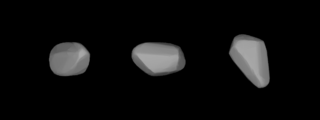Related Research Articles

Lucretia is an asteroid belonging to the Flora family in the Main Belt. It was discovered by Austrian astronomer Johann Palisa on 31 October 1888 in Vienna, and is named after the middle name of Caroline Herschel, one of the first female astronomers. Light curves of this asteroid show a synodic rotation period of 4.349±0.001 h with an amplitude of 0.3–0.4 magnitude. The spin axis appears nearly perpendicular to the ecliptic.

Constantia is a stony background asteroid from the inner region of the asteroid belt, approximately 6.5 kilometers in diameter. It was discovered by Austrian astronomer Johann Palisa at the Vienna Observatory on 4 September 1891. The asteroid is a member of the Flora family. It is spinning with a rotation period of 5.345±0.003 h and shows a brightness variation of 0.57±0.2 in magnitude.

Gisela is an asteroid belonging to the Flora family in the Main Belt that has an unusually high albedo.

Amicitia is a typical Main belt asteroid that is a member of the Flora family. It was discovered by Auguste Charlois on 19 May 1893 in Nice.
Berolina is a typical Main belt asteroid.
Monachia is an asteroid orbiting within the Flora family in the Main Belt.
Gryphia is an S-type asteroid belonging to the Flora family in the Main Belt. Its diameter is about 15 km and it has an albedo of 0.168.

Rosamunde is an S-type asteroid belonging to the Flora family in the Main Belt. Its diameter is about 19 km and it has an albedo of 0.243 . Its rotation period is 9.336 hours.

Kundry is an S-type asteroid belonging to the Flora family in the Main Belt. Its rotation period is 12.605 hours.

685 Hermia is an S-type asteroid belonging to the Flora family in the Main Belt. Its diameter is about 11 km and it has an albedo of 0.281.
700 Auravictrix is an asteroid belonging to the Flora family in the Main Belt. Its diameter is about 15 km and it has an albedo of 0.246. Its rotation period is 6.075 hours.

770 Bali is a minor planet orbiting the Sun. It is a member of the Flora family. It was discovered on 31 October 1913, by German astronomer Adam Massinger at the Heidelberg Observatory in southwest Germany. The asteroid was probably named after the Indonesian island of Bali, as the discoverer had named a couple other asteroids after places in Indonesia. The alternative hypothesis is that it was named after Bali, king of the Daityas in Hindu mythology.

800 Kressmannia is an S-type asteroid belonging to the Flora family in the Main Belt. Its rotation period is 4.464 hours.
823 Sisigambis is an asteroid belonging to the Flora family in the Main Belt. Its diameter is about 17 km and it has an albedo of 0.179. Its rotation period is unknown but appears to be greater than at least 12 hours. The asteroid is named after Sisygambis, the mother of Darius III of Persia.
871 Amneris is a minor planet orbiting the Sun. It is the namesake of the Amneris family, a subgroup of the Flora family of Main Belt asteroids.
883 Matterania is an S-type asteroid belonging to the Flora family in the Main Belt. Its rotation period is 5.64 hours
901 Brunsia is an S-type asteroid belonging to the Flora family in the Main Belt. Its rotation period is 3.136 hours.
905 Universitas is an S-type asteroid orbiting in the Main belt as part of the Flora family. Its diameter is about 21 km and it has an albedo of 0.085. Its rotation period is approximately 14.2 hours.

915 Cosette is an S-type asteroid belonging to the Flora family of Main Belt asteroids. Its rotation period is 4.445 hours.
935 Clivia belongs to the Flora family of Main Belt asteroids. Its diameter is about 7.9 km and it has an albedo of 0.197 .
References
- ↑ "841 Arabella (1916 AL)". JPL Small-Body Database . NASA/Jet Propulsion Laboratory . Retrieved 4 May 2016.
- 1 2 Kryszczynska, A.; et al. (October 2012). "Do Slivan states exist in the Flora family?. I. Photometric survey of the Flora region". Astronomy & Astrophysics. 546: 51. Bibcode:2012A&A...546A..72K. doi: 10.1051/0004-6361/201219199 . A72.